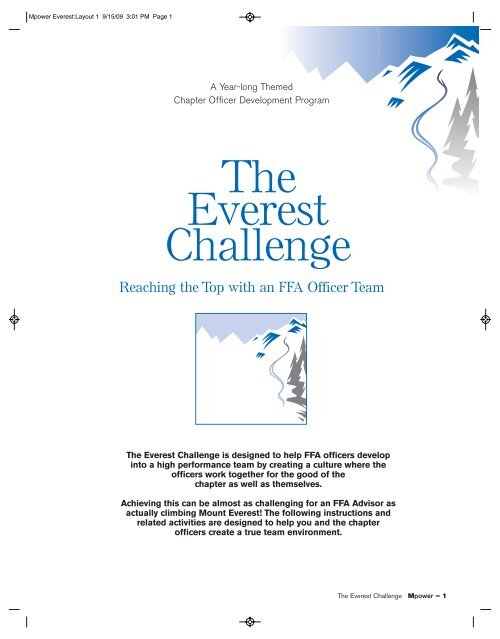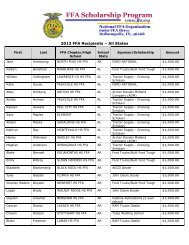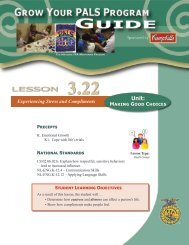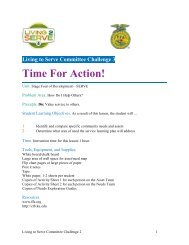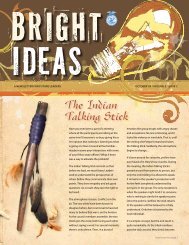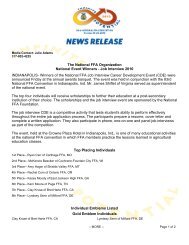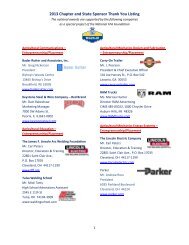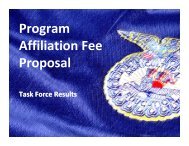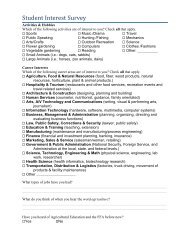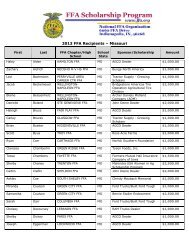The Everest Challenge - National FFA Organization
The Everest Challenge - National FFA Organization
The Everest Challenge - National FFA Organization
Create successful ePaper yourself
Turn your PDF publications into a flip-book with our unique Google optimized e-Paper software.
Mpower <strong>Everest</strong>:Layout 1 9/15/09 3:01 PM Page 1<br />
A Year-long <strong>The</strong>med<br />
Chapter Officer Development Program<br />
<strong>The</strong><br />
<strong>Everest</strong><br />
<strong>Challenge</strong><br />
Reaching the Top with an <strong>FFA</strong> Officer Team<br />
<strong>The</strong> <strong>Everest</strong> <strong>Challenge</strong> is designed to help <strong>FFA</strong> officers develop<br />
into a high performance team by creating a culture where the<br />
officers work together for the good of the<br />
chapter as well as themselves.<br />
Achieving this can be almost as challenging for an <strong>FFA</strong> Advisor as<br />
actually climbing Mount <strong>Everest</strong>! <strong>The</strong> following instructions and<br />
related activities are designed to help you and the chapter<br />
officers create a true team environment.<br />
<strong>The</strong> <strong>Everest</strong> <strong>Challenge</strong> Mpower — 1
Mpower <strong>Everest</strong>:Layout 1 9/15/09 3:01 PM Page 2<br />
Acknowledgements<br />
Mpower is made possible through the generous support of the<br />
Bayer CropScience as a special project of the <strong>National</strong> <strong>FFA</strong> Foundation.<br />
© 2004, 2005<br />
<strong>The</strong> <strong>FFA</strong> Mission: <strong>FFA</strong> makes a positive difference in the lives of students by<br />
developing their potential for premier leadership, personal growth and<br />
career success through agricultural education.<br />
<strong>The</strong> Agricultural Education Mission: Agricultural Education prepares students for<br />
successful careers and a lifetime of informed choices in the global agriculture, food,<br />
fiber and natural resources systems.<br />
<strong>The</strong> <strong>National</strong> <strong>FFA</strong> <strong>Organization</strong> is a resource and support organization that does not<br />
select, control or supervise state association, local chapter or individual<br />
member activities except as expressly provided for in the<br />
<strong>National</strong> <strong>FFA</strong> <strong>Organization</strong> Constitution and Bylaws.<br />
<strong>The</strong> <strong>National</strong> <strong>FFA</strong> <strong>Organization</strong> affirms its belief in the value of all human beings and<br />
seeks diversity in its membership, leadership and staff as an<br />
equal opportunity employer.
Mpower <strong>Everest</strong>:Layout 1 9/15/09 3:01 PM Page 1<br />
Training Camp<br />
Advisor Instructions<br />
(Preparing a Team for the <strong>Everest</strong> <strong>Challenge</strong>)<br />
Introduction:<br />
Wouldn’t it be wonderful if every officer on the team was a<br />
mature, responsible, vision oriented young person who liked everyone<br />
else on the team? It would even be better if each person had a<br />
deep trust of all other team members. Rarely, if ever, does this combination<br />
exist, at least in the beginning. Before a group of mountain<br />
climbers take on Mt. <strong>Everest</strong>, they first go through training and<br />
equip themselves with necessary supplies for the climb. In order for<br />
an <strong>FFA</strong> officer team to be effective, they need training and skills to<br />
accomplish their “climb to leadership.” At Training Camp, officers<br />
will design and equip a “Supply Pack” with necessary tools for their<br />
climb. <strong>The</strong>se activities center around creating a “team culture” that<br />
empowers young people to create effective teams and emerge from<br />
this experience as stronger leaders.<br />
Objectives:<br />
1. Identifying the expectations<br />
a. Advisor expectations of the team<br />
b. Officer expectations of the team<br />
2. Developing team and chapter goals<br />
3. Evaluating Team, Officer and Chapter<br />
Performance<br />
<strong>The</strong> <strong>Everest</strong> <strong>Challenge</strong> Mpower — 1
Mpower <strong>Everest</strong>:Layout 1 9/15/09 3:01 PM Page 2<br />
I. Identifying Expectations<br />
Materials Needed: TM 1, Supply Pack Activity Sheet # 1, “Supply Pack” for each officer. (Note:<br />
Supply Packs are to be some type of storage system where activity sheets completed in this section<br />
can be retrieved for evaluating progress later. This could be as simple as a file folder or perhaps if<br />
you require your officers to have planners, this information could be stored there. If you want a<br />
more creative approach, you could possibly give each officer a paper bag and have them design it to<br />
look like a back-pack. At the end of this lesson, all documents will be placed in their “Supply Pack.”<br />
You may want packs stored in one location, such as your classroom, so they are always available for<br />
future use.)<br />
A. <strong>The</strong> Supply Pack Activity # 1 Team Expectations – This activity is designed to help<br />
both advisors and officers identify expectations for the team. Give out Supply Pack<br />
Activity # 1 and “Supply Packs.” Allow time to design Supply Packs if needed. Both<br />
officers and advisors should complete this activity. You will need TM 1 for part 3 of<br />
Supply Pack Activity 1.<br />
Explain to team: “In this activity, you are to identify expectations for our officer team.<br />
This will build the foundation for our team this year. Please follow the instructions on<br />
the Supply Pack Activity # 1. I/We (advisors) will be completing this with you.”<br />
Follow the instructions on Supply Pack Activity # 1. After completion, each person<br />
will place this sheet in their Supply Pack for later use.<br />
II. Team and Chapter Goals<br />
NOTE: It can be very beneficial to set a team mission<br />
statement before setting goals. Team goals should arise out<br />
of the mission statement created by the team. For help in<br />
developing a team mission statement, refer to<br />
LifeKnowledge Curriculum CD – Advanced High School<br />
Lesson 21, Establishing a Team Mission.<br />
Materials Needed: Supply Pack Activity Sheet # 2 (one for<br />
each topic to be brainstormed) and Supply Pack Activity<br />
Sheet # 3 (one for each final goal), Poster board 24” x 24”,<br />
10-12 pieces of light-colored 3” x 10” construction paper<br />
such as white, yellow, orange, etc., colored markers, and<br />
rubber cement.<br />
Establishing team and chapter goals provides a road map<br />
and reference point for officers and chapter members. It is<br />
important for these to be student driven. However, it is<br />
appropriate and necessary for the advisor to evaluate the<br />
work to guide the team towards goals that are worthy and<br />
beneficial for the chapter.<br />
Team Goals:<br />
- Follow correct parliamentary procedure<br />
at each meeting<br />
- Have an officer meeting one day prior<br />
to each chapter meeting<br />
- Meet all team expectations identified<br />
in Supply Pack # 1<br />
Chapter Goals:<br />
- Achieve $15,000 in fruit sales<br />
- Organize farm equipment rescue<br />
training for area emergency personnel<br />
- Have 80% of members involved in an<br />
activity above the chapter level<br />
What type of goals should an officer team develop? This really depends on each individual chapter. It<br />
is beneficial for a team to have goals specific to the team as well as overall goals for the chapter. In<br />
the box above are several examples of team goals and chapter goals.<br />
2— Mpower <strong>The</strong> <strong>Everest</strong> <strong>Challenge</strong>
Mpower <strong>Everest</strong>:Layout 1 9/15/09 3:01 PM Page 3<br />
A. Supply Pack Activity # 2 – Snow Balling - Ideas to Take Us to the Top – <strong>The</strong><br />
purpose of this activity is to initiate ideas on team and chapter goals. An alternative<br />
to this can be found on the LifeKnowledge Curriculum CD – High School Lesson 79,<br />
Setting Team Expectations.<br />
1. Snowballing (Brainstorming) – Snowballing is used to generate ideas. <strong>The</strong><br />
group will pick an area of challenge and generate ideas to help meet that challenge.<br />
In the case of climbing Mt. <strong>Everest</strong>, the challenge would be reaching the<br />
top. For an officer team, the challenge is leading the chapter to desired outcomes.<br />
<strong>The</strong> main purpose is to rapidly generate ideas related to chapter operations.<br />
Here is how Snowballing works:<br />
A. Divide the team into groups of two or three people.<br />
B. Each group will be given a Supply Pack Sheet # 2. <strong>The</strong>se sheets will have<br />
topics related to chapter operations and activities listed at the top. <strong>The</strong> number<br />
of sheets handed out will depend on the topics for which the team needs<br />
to brainstorm ideas for. Advisors may want to prepare some topics in<br />
advance and the team should be allowed to pick topics they have a particular<br />
interest in.<br />
Examples:<br />
Topic: Chapter Fundraising<br />
Ideas: fruit sales, dunking booth at fair, pie eating contest at fall<br />
festival, labor auction<br />
Topic:<br />
Ideas:<br />
<strong>FFA</strong> Meetings<br />
Use parliamentary procedure each meeting,<br />
provide donuts to members who are on time, post agenda in<br />
advance, throw out candy to non-officers who move motions.<br />
C. Give the group 3-5 minutes to generate ideas related to the topics they have.<br />
Each group is to write ideas down on the sheet. When time is up, each group<br />
will exchange their sheet with another group. <strong>The</strong>y will again have 3-5 minutes<br />
to generate ideas on your new topic. This continues until each group<br />
has had a chance to generate ideas on each topic provided.<br />
D. After each group has had a chance to generate ideas on each topic, place the<br />
topics and ideas where everyone can see them (you may need to write them<br />
on a board or flip chart.)<br />
E. Each team member gets three votes per topic area. You may assign all your<br />
votes to one idea or use them to select three ideas.<br />
F. <strong>The</strong> top ideas (there may be several in each topic area) will form the basis<br />
for team and chapter goals.<br />
Snowballing Rules:<br />
1. <strong>The</strong>re are no dumb ideas. All ideas are welcome regardless how funny or wild it may<br />
seem.<br />
2. Don’t criticize, groan or laugh. This is not a debate or discussion. Talking about ideas<br />
will take place later.<br />
3. It is okay to piggy-back your idea onto another’s idea. One idea often generates more!<br />
4. <strong>The</strong> more ideas the better.<br />
5. By the way, have fun. Enjoying what you do helps creative juices flow!<br />
<strong>The</strong> <strong>Everest</strong> <strong>Challenge</strong> Mpower — 3
Mpower <strong>Everest</strong>:Layout 1 9/15/09 3:01 PM Page 4<br />
Explain to team: “We will be “snowballing” ideas to set up the foundation for team<br />
and chapter goals. Before we start, there are some important rules everyone must<br />
agree to abide by.” (Cover Snowballing Rules above.)<br />
Explain to team: “You are to generate ideas that are specific for this team as well as<br />
the whole chapter.” (Give examples of Team goals and Chapter goals from above.)<br />
Explain to team: “<strong>The</strong> activity will use the following procedure. (Explain the procedure<br />
A-F above to team.) Does anyone have any questions? If not, ready, begin.<br />
B. Supply Pack Activity # 3 – Reaching the Top Through Goal Achievement: In order to<br />
achieve the goal of reaching the top of a mountain, climbers have a plan to follow.<br />
For an officer team to be effective, it also needs a plan for each goal. Handout Supply<br />
Pack Activity Sheet # 3 to each officer. You will need an activity sheet for each goal<br />
identified in Supply Pack Activity # 2. Use the following steps to develop a plan for<br />
achieving team and chapter goals.<br />
Step 1 –<br />
Team Goal:<br />
Chapter Goal:<br />
Step 2 –<br />
Incorrect -<br />
Correct –<br />
Sort goals into chapter or team goals. You may want to list the<br />
goals on a board or flip chart. Example goals:<br />
Hold an officer meeting one day prior to each chapter meeting.<br />
Have 80% of chapter members involved in an activity above the<br />
chapter level.<br />
Using the “Supply Pack Activity Sheet # 3”, direct team members<br />
to list and plan out each goal. You may want to plan each<br />
goal as a team or split the team into 2 or 3 groups and assign<br />
goals to each group. If you use the small group approach, you<br />
should have each group review its goals with the whole team for<br />
approval. To save time, you may have one person recording the<br />
plans on Activity Sheet # 3 and then photocopy for each officer.<br />
NOTE: It would be a good idea to present the chapter goals at<br />
a chapter meeting for approval of the membership. Remember<br />
to make goals that are specific and measurable. See examples<br />
below.<br />
We want to get more members in our chapter. (This goal is not<br />
specific or measurable. Is one member enough, ten, etc.)<br />
Increase membership by 15 members. (This goal is very specific<br />
and easily measured. It provides a “bulls eye” for the chapter to<br />
hit.)<br />
Explain to students: “Now that we have narrowed our ideas to specific goals,<br />
you will plan each goal out. Follow the guidelines on Supply Pack Activity # 3.<br />
Remember to make the goals specific and measurable.” (Show students examples<br />
of incorrect and correct ways to write goals.)When this is complete, each<br />
officer will place a set of goals in their supply pack.<br />
4— Mpower <strong>The</strong> <strong>Everest</strong> <strong>Challenge</strong>
Mpower <strong>Everest</strong>:Layout 1 9/15/09 3:01 PM Page 5<br />
Step 3 –<br />
Step 4 -<br />
Climbing the Mountain: Just as mountain<br />
climbers stay focused on the peak as<br />
their destination, officer teams must also<br />
keep their goals in sight. In this activity, the officer team will<br />
create a visual aid to help them focus on their goals. Follow the<br />
directions below.<br />
a. Find a location that team and chapter members will frequently<br />
see, such as a wall area in the classroom. A space<br />
large enough to accommodate a 24” x 24” poster board is<br />
needed.<br />
b. Instruct officer team to create a drawing of a mountain (Use<br />
TM 3 as an example). It should be large enough to be easily<br />
visible. Use poster board that is approximately 24” x 24” for<br />
drawing. Note: Depending on time available, advisor may<br />
choose to have mountain created in advance.<br />
Make a list of each team and chapter goal that was planned<br />
in Supply Pack Activity 3. Write these goals directly on the<br />
mountain or place it on a separate sheet of paper and<br />
attach to mountain. (Refer to TM 2).<br />
d. Using the 3” x 10” pieces of light colored construction<br />
paper, number each piece of paper to correspond with each<br />
of the team and chapter goals. Attach these pieces to the<br />
mountain.<br />
e. In order to ascend to the top of Mt. <strong>Everest</strong>, the chapter<br />
must complete all of its goals. As goals are achieved, write<br />
the level of accomplishment and date achieved on one of the<br />
3” x 10” pieces of paper attached to the mountain (Refer to<br />
TM 2).<br />
(Optional) It is convenient for both advisors and officers to have<br />
a quick reference chart relating to goals set by the chapter. A<br />
quick look to see what goals need work, who is in charge and<br />
when deadlines are due, can help keep a team on track.. Refer<br />
to Supply Pack Activity Supplement # 3 for this chart. Below is<br />
an example of what might be written on this chart:<br />
GOAL &<br />
STEPS<br />
MEMBER/S<br />
IN CHARGE<br />
DUE<br />
DATE DONE<br />
Goal: Achieve $15,000 in Fruit Sales<br />
5-Nov<br />
Step 1 - Contact fruit supplier on prices Scott L. 20-Sep<br />
Step 2 - Create sales slips for members Sable B., 1-Oct<br />
Jesse F.,<br />
Michal S.,<br />
Maika B.<br />
Step 3 - Compile orders Joel G., Kory K., 28-Oct<br />
Chelsea L, Ryan S.,<br />
Bobbi T.<br />
Step 4 - Send order Scott L. & Mr. Jones 5-Nov<br />
Goal: Recruitment Letters to Incoming<br />
Freshman<br />
1-Aug<br />
Step 1: Create Letter Chelsea L. & Maika B. 25-Jul<br />
Step 2: Get mailing addresses Scott L. & Bobbie T. 25-Jul<br />
or email addresses<br />
Step 3: Mail letters Chelsea L. & Maika B. 25-Jul<br />
<strong>The</strong> <strong>Everest</strong> <strong>Challenge</strong> Mpower — 5
Mpower <strong>Everest</strong>:Layout 1 9/15/09 3:01 PM Page 6<br />
III. Evaluating Team, Individual and Chapter Performance<br />
Periodically, the officer team and advisors need to evaluate team and individual performance,<br />
and make adjustments if necessary. <strong>The</strong> following Supply Pack activities could be used at a<br />
mid-year officer retreat.<br />
A. Team Performance Evaluation<br />
Materials Needed: Supply Pack Activity Sheet # 4 (one per officer), Supply Packs<br />
and Supply Pack Activity Sheet # 1, Supply Pack Supplemental Activity Sheet # 4,<br />
Supply Pack Activity Sheet # 5, Supply Pack Activity Sheet # 6 (one for each goal),<br />
TM 3.<br />
1. Supply Pack Activity # 4 – Team Performance Evaluation: To begin, have each<br />
officer retrieve their Supply Packs. Instruct them to take out Supply Pack<br />
Activity Sheet # 1. Hand each member a copy of Supply Pack Activity # 4.<br />
Members should review team expectations from Sheet # 1. On Sheet # 4, in the<br />
rank column, instruct team members to write the number of votes each expectation<br />
received from Sheet # 1. Now have students score how well the team is<br />
meeting each expectation based on the scale listed at the top of Sheet # 4. <strong>The</strong><br />
team will need to rank all expectations, even if they were not among the top ones<br />
voted on by team. Note: Emphasize being honest in their evaluation.<br />
Explain to students: “Using the Team Performance Evaluation sheet, score each of<br />
the team expectations based on the scoring chart the scoring chart listed at the top<br />
of the sheet. Please be honest and sincere. After completion of chart, hand them in to<br />
me.”<br />
B. Individual Performance Evaluation<br />
1. Supply Pack Activity # 5: After completion of team evaluation, distribute Supply<br />
Pack Activity Sheet # 5. Each officer is to complete this self-evaluation. Place<br />
emphasis on honesty and sincerity when completing this sheet. After officers<br />
have completed scoring section, instruct them to list any areas they need to<br />
improve on to become a more effective team member. When completed, officers<br />
should make two copies, place one sheet in their supply pack and hand the other<br />
to the instructor.<br />
Note: <strong>The</strong> purpose of Activity Sheet # 5 is to make students think about what<br />
expectations exist for team members. While it is meant as self-reflective activity<br />
for officers, this evaluation could form the basis of an improvement plan between<br />
the advisor and an officer who is not meeting expectations.<br />
Explain to students: “Complete the Officer Self-Performance Evaluation. Please<br />
be honest and sincere in completing this form. Once you are finished with scoring,<br />
list any areas you need to improve on as a team member. When finished<br />
make a copy of your evaluation, place one in your Supply Pack and hand one in<br />
to me.”<br />
6— Mpower <strong>The</strong> <strong>Everest</strong> <strong>Challenge</strong>
Mpower <strong>Everest</strong>:Layout 1 9/15/09 3:01 PM Page 7<br />
a. While officers are completing Sheet # 5, the advisor can use Supply Pack<br />
Supplemental Activity Sheet # 4 to record and average each officer’s team<br />
evaluation scores from Activity Sheet # 4. When all scores from each<br />
Activity Sheet 4 are entered and averaged, examine areas where the team<br />
may be falling short of expectations. Use TM 3 Supply Pack 4 to display<br />
team averages compared to original expectation rank. Discuss solutions to<br />
improve performance where team may be falling short.<br />
Explain to students: “Please examine the following team averages compared<br />
to the original rank of expectations. Are we meeting those expectations or<br />
do we need to discuss possible areas of improvement?”<br />
C. Chapter Performance<br />
Supply Pack Activity # 6 – How Far Have We Come: After completing team and<br />
individual evaluation, the officer team needs to evaluate how far the chapter has progressed.<br />
Refer to wall chart, made earlier, displaying the mountain and goals. Split<br />
the team into 2 or 3 groups. Randomly assign both accomplished goals and goals<br />
not met to each group. Instruct groups to complete Activity Sheet # 6 for each goal<br />
they have been assigned. When groups are finished, discuss with the group what they<br />
learned and how it can be applied to unfinished goals and future officer teams. At<br />
the end of discussion, collect all sheets. <strong>The</strong>se can be used to help future officer teams<br />
establish goals and avoid mistakes.<br />
Explain to team: “Each group will be assigned goals, both those accomplished and<br />
not accomplished. Complete Supply Pack Activity # 6, including suggested goals and<br />
for future officer teams on each goal assigned. After you complete this evaluation we<br />
will discuss successes, failures and make suggestions for improvements. You have 5<br />
minutes per goal. Are there questions, you may begin.”<br />
<strong>The</strong> <strong>Everest</strong> <strong>Challenge</strong> Mpower — 7
Mpower <strong>Everest</strong>:Layout 1 9/15/09 3:01 PM Page 9<br />
Team Expectations<br />
Instructions: Mountain climbers are wel-prepared and have the correct<br />
supplies to accomplish their mission. This is also true for effective teams.<br />
For a team to achieve its mission and goals, everyone must be aware of<br />
what is expected. Complete the following exercises related to team<br />
expectations.<br />
1. What Are the Most Important Expectations for a Successful Team?: Circle<br />
five expectations you believe are most important in order for your officer team to be<br />
successful. In the blank spaces, write down team expectations not listed that you<br />
feel are essential for this team to be successful.<br />
A. <strong>The</strong> team has a clear mission and goals developed and supported by the team.<br />
B. A climate of trust exists among the team.<br />
C. Team members genuinely listen to each other.<br />
D. Differences of opinion are encouraged and freely expressed.<br />
E. Each team member is aware of their specific tasks and works to accomplish<br />
them.<br />
F. Open communication exists among team members both in and out of team<br />
setting.<br />
G. Shared leadership roles – Focus on how best to get a project done, not who<br />
controls it.<br />
H. Each team member counts as a valuable part of the team.<br />
I. When team performance breaks down, members focus on solutions rather than<br />
blame.<br />
J. Interpersonal issues and competitive struggles are not allowed to drain team<br />
energies.<br />
K. Team members affirm and support each other.<br />
L. Team members are deeply committed to the success of the team.<br />
M. Team atmosphere is informal, comfortable free from tension.<br />
N. Team members periodically evaluate team performance and make necessary<br />
changes.<br />
____________________________________________________________________<br />
____________________________________________________________________<br />
____________________________________________________________________<br />
____________________________________________________________________<br />
Supply Pack Activity 1<br />
<strong>The</strong> <strong>Everest</strong> <strong>Challenge</strong> Mpower — 9
Mpower <strong>Everest</strong>:Layout 1 9/15/09 3:01 PM Page 10<br />
Supply Pack Activity 1<br />
2. Take 5-10 minutes for team members and advisor(s) briefly to discuss which expectations<br />
they selected and why.<br />
3. All of the above expectations are often identified as necessary to team success.<br />
However, your team may have some expectations that need more attention than<br />
others. Place the list on the board for everyone to see (a transparency has been<br />
provided). Each officer and advisor will vote on those expectations they believe the<br />
team needs to focus on first.<br />
Method of Voting - Each team member has five votes. Using an erasable marker,<br />
each team member will go to where the list is displayed and cast votes for the<br />
expectations they feel must be met first. In this process, you can use one vote on<br />
five different expectations or you can place all five votes on one expectation you<br />
feel is most important. If an expectation you believe is important is not listed, write<br />
it on the list.<br />
4. After voting is completed, return to the list above and rank the top 5-vote receiving<br />
expectations. (<strong>The</strong> number of expectations for the team to select as key expectations<br />
to focus on is up to the team. It might be 5, 7, 10, etc.)<br />
5. Each member should place this list in his or her “supply pack” for future reference.<br />
10 — Mpower <strong>The</strong> <strong>Everest</strong> <strong>Challenge</strong>
Mpower <strong>Everest</strong>:Layout 1 9/15/09 3:01 PM Page 11<br />
Snowballing –<br />
Ideas to Take Us to the Top!<br />
Introduction: Generate ideas on the following team/chapter topic.<br />
Remember, there are no dumb ideas. <strong>The</strong> main purpose is to generate as<br />
many ideas related to this topic as possible in the time allotted. Don’t be<br />
afraid to “piggy-back” on another person’s idea. Have fun!<br />
Topic:__________________________________________________________<br />
Write Your Ideas Below<br />
Supply Pack Activity 2<br />
<strong>The</strong> <strong>Everest</strong> <strong>Challenge</strong> Mpower — 11
Mpower <strong>Everest</strong>:Layout 1 9/15/09 3:01 PM Page 12<br />
Supply Pack Activity 3<br />
Goal:<br />
Reaching the Top Through Goal<br />
Achievement<br />
__________________________________________________________<br />
Steps to Accomplishing Goal: (Note: You may only need to complete one<br />
step to accomplish the goal. However, some goals may require more than<br />
one step.)<br />
Step 1:<br />
Step 2:<br />
Step 3:<br />
What needs to be done?<br />
Who is in charge? _________________________________<br />
Additional support team needed (who will help with this?)<br />
Date to be accomplished by: _________________________<br />
What needs to be done?<br />
Who is in charge? _________________________________<br />
Additional support team needed (who will help with this?)<br />
Date to be accomplished by: _________________________<br />
What needs to be done?<br />
Who is in charge? _________________________________<br />
Additional support team needed (who will help with this?)<br />
Date to be accomplished by: _________________________<br />
12 — Mpower <strong>The</strong> <strong>Everest</strong> <strong>Challenge</strong>
Mpower <strong>Everest</strong>:Layout 1 9/15/09 3:01 PM Page 13<br />
Reaching the Top Through Goal<br />
Achievement<br />
<strong>FFA</strong> Chapter Goal Chart<br />
Member(s) Due<br />
Goal & Steps in Charge Date Done<br />
Supply Pack Activity 3<br />
<strong>The</strong> <strong>Everest</strong> <strong>Challenge</strong> Mpower — 13
Mpower <strong>Everest</strong>:Layout 1 9/15/09 3:01 PM Page 14<br />
Supply Pack Activity 4<br />
Team Performance Evaluation<br />
Instructions: Each officer and advisor is to score the teams performance on<br />
the expectations listed below. Score the team on each expectation by writing<br />
the number in the score column to the left of each expectation. <strong>The</strong> scoring is<br />
based on the following point scale:<br />
5 = Strongly Agree 4 = Agree 3 = Somewhat Disagree 2 = Disagree 1 = Strongly Disagree<br />
NOTE: <strong>The</strong> rank column is for ranking the expectations based on the team vote from<br />
Supply Pack Activity # 1. Blank spaces are for additional expectations the team may<br />
have.<br />
Score Rank<br />
Total<br />
Score<br />
TEAM EXPECTATIONS<br />
<strong>The</strong> team has a clear mission and goals developed and supported by the team.<br />
A climate of trust exists among the team members.<br />
Team members genuinely listen to each other.<br />
Differences of opinion are encouraged and freely expressed.<br />
Each team member is aware of his or her specific tasks and works to accomplish them.<br />
Open communication exists among team members both in and out of team setting.<br />
Shared leadership roles – Focus on how best to get a project done, not who controls it.<br />
Each team member counts as a valuable part of the team.<br />
When team performance breaks down, members focus on solutions rather than blame.<br />
Interpersonal issues and competitive struggles are not allowed to drain team energies.<br />
Team members affirm and support each other.<br />
Team members are deeply committed to the success of the team.<br />
Team atmosphere is informal, comfortable, and free from tension.<br />
Team members periodically evaluate team performance and make necessary changes.<br />
Comments: Place comments related to expectations you feel are not being met and causing the team to be<br />
less effective than it could be. Use the back of this sheet if necessary. Hand in to advisor when completed.<br />
14 — Mpower <strong>The</strong> <strong>Everest</strong> <strong>Challenge</strong>
Mpower <strong>Everest</strong>:Layout 1 9/15/09 3:01 PM Page 15<br />
Officer Self-Performance Evaluation<br />
Instructions: Each officer is to score his/her performance on the expectations<br />
listed below. Score yourself on each expectation by writing the number<br />
in the score column to the left of each expectation. <strong>The</strong> scoring is based on<br />
the following point scale:<br />
5 = Strongly Agree 4 = Agree 3 = Somewhat Disagree 2 = Disagree 1 = Strongly Disagree<br />
Note: Blank spaces are for additional expectations you may have of yourself.<br />
Score<br />
Self-Expectations as an Officer<br />
I have a clear understanding of the team mission and goals and work to achieve them.<br />
I have a high level of trust of the other team members.<br />
I am a trustworthy team member.<br />
I always practice genuine listening when communicating with team members.<br />
I encourage other team members to freely express differences of opinion<br />
I am aware of my specific duties as an officer and work hard to accomplish them.<br />
I openly communicate with other team members both in and out of the team setting.<br />
I willingly share leadership and focus on accomplishing tasks rather than controlling them.<br />
I believe each team member counts and is a valuable part of the team.<br />
When something goes wrong I look for solutions rather than placing blame.<br />
I do not allow my interpersonal issues or competitive struggles to affect the team effort.<br />
I affirm and support all members of the team.<br />
I am deeply committed to the success of the team.<br />
I help to keep the team atmosphere informal, comfortable and free from tension.<br />
I periodically evaluate my performance and make adjustments to be more effective.<br />
Areas for Improvement: Please list any areas that need improvement. Also, list what steps you plan to<br />
take for each area that needs improvement. Use back side of sheet if needed. After completion, make a copy<br />
and hand one to the advisor and place the other one in your “Supply Pack.”<br />
Supply Pack Activity 5<br />
<strong>The</strong> <strong>Everest</strong> <strong>Challenge</strong> Mpower — 15
Mpower <strong>Everest</strong>:Layout 1 9/15/09 3:01 PM Page 16<br />
Supply Pack Activity 6<br />
How Far Have We Come?<br />
(Evaluating Progress Towards Goals)<br />
Goal:____________________________________________<br />
1. Was goal the accomplished as planned? Yes No<br />
2. What worked well?<br />
a.<br />
b.<br />
c.<br />
3. What did not work well?<br />
a.<br />
b.<br />
c.<br />
4. Suggested goals and actions for future officer teams.<br />
16 — Mpower <strong>The</strong> <strong>Everest</strong> <strong>Challenge</strong>
Mpower <strong>Everest</strong>:Layout 1 9/15/09 3:01 PM Page 17<br />
Votes<br />
Team Expectation List<br />
_____ <strong>The</strong> team has a clear mission and goals developed and supported by the team.<br />
_____ A climate of trust exists among the team members.<br />
_____ Team members genuinely listen to each other.<br />
_____ Differences of opinion are encouraged and freely expressed.<br />
_____ Each team member is aware of his or her specific tasks and works to accomplish them.<br />
_____ Open communication exists among team members both in and out of the team setting.<br />
_____ Shared leadership roles – Focus on how best to get a project done, not who<br />
controls it.<br />
_____ Each team member counts as a valuable part of the team.<br />
_____ When team performance breaks down, members focus on solutions rather than<br />
blame.<br />
Supply Pack 1<br />
_____ Interpersonal issues and competitive struggles are not allowed to drain team<br />
energies.<br />
_____ Team members affirm and support each other.<br />
_____ Team members are deeply committed to the success of the team.<br />
_____ Team atmosphere is informal, comfortable and free from tension.<br />
_____ Team members periodically evaluate team performance and make necessary<br />
changes.<br />
_____ ____________________________________________________________________<br />
_____ ____________________________________________________________________<br />
_____ ____________________________________________________________________<br />
_____ ____________________________________________________________________<br />
<strong>The</strong> <strong>Everest</strong> <strong>Challenge</strong> Mpower — 17
Mpower <strong>Everest</strong>:Layout 1 9/15/09 3:01 PM Page 18<br />
Supply Pack 2<br />
<strong>The</strong> <strong>Everest</strong> <strong>Challenge</strong><br />
Reaching the Top Through Goal Achievement<br />
This Year’s Chapter Goals<br />
Goal 1: Get 50% of incoming freshmen to take Agricultural<br />
Education classes and join <strong>FFA</strong><br />
Goal 2: Reacg $20,000 in fruit sales<br />
Goal 3: Encourage 70% of membership to participate in<br />
a chapter<br />
Goal 4: Earn a Three Star Chapter rating<br />
Goal 5: Qualify one or more teams for a <strong>National</strong> Career<br />
Development Event<br />
Final Goal to Be Achieved<br />
Goal 3: 43 out of 52 members participated in an<br />
<strong>FFA</strong> event above district level.<br />
Date achieved: 2/28<br />
Goal 2: Chapter sold $22,000 during fruit sale.<br />
Date achieved: 11/5<br />
Goal 1: 18 out of 33 freshmen joined <strong>FFA</strong><br />
and Agricultural Education classes.<br />
Date achieved: 9/30<br />
18 — Mpower <strong>The</strong> <strong>Everest</strong> <strong>Challenge</strong>
Mpower <strong>Everest</strong>:Layout 1 9/15/09 3:01 PM Page 19<br />
Team<br />
Avg.<br />
Evaluation of Team Expectation List<br />
Orig.<br />
Rank<br />
_____ _____ <strong>The</strong> team has a clear mission and goals developed and supported by the<br />
team.<br />
_____ _____ A climate of trust exists among the team members.<br />
_____ _____ Team members genuinely listen to each other.<br />
_____ _____ Differences of opinion are encouraged and freely expressed.<br />
_____ _____ Each team member is aware of his or her specific tasks and works to<br />
accomplish them.<br />
_____ _____ Open communication exists among team members both in and out of<br />
team setting.<br />
_____ _____ Shared leadership roles – Focus on how best to get a project done, not<br />
who controls it.<br />
_____ _____ Each team member counts as a valuable part of the team.<br />
_____ _____ When team performance breaks down, members focus on solutions<br />
rather than blame.<br />
_____ _____ Interpersonal issues and competitive struggles are not allowed to drain<br />
team energies.<br />
Supply Pack 3<br />
_____ _____ Team members affirm and support each other.<br />
_____ _____ Team members are deeply committed to the success of the team.<br />
_____ _____ Team atmosphere is informal, comfortable and free from tension.<br />
_____ _____ Team members periodically evaluate team performance and make necessary<br />
changes.<br />
<strong>The</strong> <strong>Everest</strong> <strong>Challenge</strong> Mpower — 19
Mpower <strong>Everest</strong>:Layout 1 9/15/09 3:01 PM Page 21<br />
Passing Knowledge from one Team to the Next<br />
Reading the Mountain<br />
Voices from the Past<br />
Mountain climbers study the mountain they are to ascend<br />
and have a plan mapped out before they leave. Part of this<br />
plan usually involves visiting with climbers who have made<br />
the ascent before. <strong>The</strong>se visits yield much information<br />
involving the best trails, what areas to avoid, and challenges<br />
that will be faced.<br />
Each year, advisors must “break in” a new officer team.<br />
This activity is designed to help a new team avoid the<br />
“dangerous crevices” and “icy slopes” that could derail a<br />
team on their way to achieving goals. It involves input from<br />
previous mountain climbers (current officers) in the form<br />
of a time capsule filled with information that is gathered<br />
during their trek towards goal achievement.<br />
<strong>The</strong> <strong>Everest</strong> <strong>Challenge</strong> Mpower — 21
Mpower <strong>Everest</strong>:Layout 1 9/15/09 3:01 PM Page 22<br />
Instructions:<br />
A. In order for this activity to be effective, it will need to begin with the present officer team and<br />
continue throughout their year of service. To introduce this activity explain the following:<br />
“As leaders, you are sometimes called upon to be coaches and mentors. You will be involved<br />
in a mentoring activity for the next officer team that follows you. During this year, your team<br />
will be recording activities and situations that work well and those that don’t. This information<br />
will be placed in a time capsule that will be presented to the new officer team when they<br />
take over their roles as officers. First we will need to construct a time capsule.<br />
B. Time Capsule Construction. <strong>The</strong>re is no set item that can be a time capsule. <strong>The</strong> following are<br />
a few ideas that could be used. Once again, encourage the team to use their imaginations and<br />
be creative. You may want to list these on a board or flip chart and give the team five minutes<br />
to brainstorm other ideas for time capsules.<br />
Explain: “<strong>The</strong> following are a few suggestions for time capsules. After looking at these spend<br />
about five minutes brainstorming to see if there are any other devices you would want to use<br />
as a time capsule.”<br />
1. Cookie tins – You may want to sand off the paint and decorate it.<br />
2. Plastic food containers from the school cafeteria.<br />
3. Decorate a box like a treasure chest.<br />
4. Round, cardboard, shipping canister used for items like posters, maps, drawings<br />
5. CD-ROM if making the time capsule electronic.<br />
Whatever device you select to use as a time capsule, it is important to direct the current officer<br />
team to design and decorate this in a fashion that helps to convey a positive message to<br />
the next officer team.<br />
C. How to record the information:<br />
1. Use the worksheets provided: “Slippery Slopes to Avoid” and “Solid Steps.” “Slippery<br />
Slopes” provide a place for officers to record those situations where things didn’t work<br />
out and advice on what to avoid. “Solid Steps” provides a place for recording those activities<br />
that worked well and that new officers may want to consider doing again. It would<br />
be a good idea to keep these worksheets in a location that is easily accessible by the current<br />
officer team. This will make it easier for them to record information as the year progresses.<br />
Explain to students:<br />
“As we move through the year, you will use these sheets to record activities. Those that<br />
worked well will be recorded on Solid Steps and situations that didn’t turn out well on<br />
the Slippery Slope sheets. We will place these in the time capsule throughout the year.”<br />
2. Electronic Option: If the current team wants to be a little more creative and the technology<br />
is available, they could make use of Power Points, video recordings, etc. With the use<br />
of electronic media allows for the integration of pictures, sounds, etc. In this situation, the<br />
time capsule could actually become a CD-ROM or a combination of worksheets from<br />
above, interactive CD-ROM, video tape, etc. This will only be limited by your imagination<br />
and available technology. A Power Point example is included on this CD-ROM.<br />
22 — Mpower <strong>The</strong> <strong>Everest</strong> <strong>Challenge</strong>
Mpower <strong>Everest</strong>:Layout 1 9/15/09 3:01 PM Page 23<br />
Passing Knowledge from one Team to the Next<br />
Slippery Slopes<br />
(Things to Avoid)<br />
Instructions: For each of the Slippery Slope areas below, assign a number,<br />
briefly explain the situation or activity and advice your team would give to the<br />
next team.<br />
Slippery Slope # ____<br />
Situation or Activity:<br />
Advice to new team:<br />
Slippery Slope # ____<br />
Situation or Activity:<br />
Advice to new team:<br />
<strong>The</strong> <strong>Everest</strong> <strong>Challenge</strong> Mpower — 23
Mpower <strong>Everest</strong>:Layout 1 9/15/09 3:01 PM Page 24<br />
Slippery Slope # ____<br />
Situation or Activity:<br />
Advice to new team:<br />
Slippery Slope # ____<br />
Situation or Activity:<br />
Advice to new team:<br />
24 — Mpower <strong>The</strong> <strong>Everest</strong> <strong>Challenge</strong>
Mpower <strong>Everest</strong>:Layout 1 9/15/09 3:01 PM Page 25<br />
Passing Knowledge from one Team to the Next<br />
Solid Steps<br />
(<strong>The</strong>se worked great,<br />
consider them for your team!)<br />
Instructions: For each of the Solid Step areas below, assign a number,<br />
briefly explain the situation or activity and explain why they may want to<br />
consider it again.<br />
Solid Step # ____<br />
Situation or Activity:<br />
Why your team might want to do this:<br />
Solid Step # ____<br />
Situation or Activity:<br />
Why your team might want to do this:<br />
<strong>The</strong> <strong>Everest</strong> <strong>Challenge</strong> Mpower — 25
Mpower <strong>Everest</strong>:Layout 1 9/15/09 3:01 PM Page 26<br />
Solid Step # ____<br />
Situation or Activity:<br />
Why your team might want to do this:<br />
Solid Step # ____<br />
Situation or Activity:<br />
Why your team might want to do this:<br />
26 — Mpower <strong>The</strong> <strong>Everest</strong> <strong>Challenge</strong>
Mpower <strong>Everest</strong>:Layout 1 9/15/09 3:01 PM Page 27<br />
Mentors and Personal Goals Workshop<br />
LIFE FORCE<br />
Staying Fit for Life’s Climb<br />
Life Force is a set of personal development workshops for <strong>FFA</strong> officers and advisors.<br />
<strong>The</strong>se three workshops can be used together or as stand alone workshops.<br />
<strong>The</strong> three workshops are:<br />
1. What’s My Mission?<br />
2. Mentors for Me<br />
3. GOALS – Guiding Our Active Life System<br />
A note to instructors: <strong>The</strong> following activities are designed with both students and advisors in mind. It is suggested<br />
that advisors complete the activities along with the <strong>FFA</strong> officers.<br />
<strong>The</strong> <strong>Everest</strong> <strong>Challenge</strong> Mpower — 27
Mpower <strong>Everest</strong>:Layout 1 9/15/09 3:01 PM Page 28<br />
Mission Development Workshop<br />
What’s My Mission?<br />
Introduction: Creating a mission statement can do several things. First, it<br />
makes you evaluate what is important in your life. Second, it serves as a guide<br />
for how to approach all aspects of life. Take a journey through the next exercises<br />
to find your mission.<br />
Pharaohs of Egypt<br />
A. <strong>The</strong> Pharaohs of ancient Egypt left instructions to fill their tombs with mementos of their life.<br />
Some included toys from their childhood, favorite weapons, jewelry, or objects which related<br />
to special important events in their lives.<br />
Pretend you are very old and approaching the end of your life. Select objects to place in your<br />
tomb that will tell a story about your life. <strong>The</strong>se objects will have to convey a message about<br />
who you were and what was most important to you, to people who never knew you. Make a<br />
list below of what you would select.<br />
B. Look over your list. Does it tell the story you want future generations to know? If not, adjust<br />
or add to it until it does. After you have completed this exercise, you should be able to focus<br />
on the truly important things in your life. This will be useful in the next exercise, Building<br />
My Mission.<br />
28 — Mpower <strong>The</strong> <strong>Everest</strong> <strong>Challenge</strong>
Mpower <strong>Everest</strong>:Layout 1 9/15/09 3:01 PM Page 29<br />
Building My Mission<br />
Introduction: Building a mission statement can be a challenging, on-going<br />
process. Don’t become stressed over finding the exact words when you begin.<br />
A mission statement will grow and change as you have new experiences and<br />
develop new visions through the journey of life. A mission statement takes<br />
into account who you are and what you want to become.<br />
A. As you begin writing your statement, ask the following questions from Stephen Covey’s <strong>The</strong> 7<br />
Habits of Highly Effective People:<br />
1. Does it say what I want from my life?<br />
2. Does it include what I value?<br />
3. Have I considered my talents?<br />
4. Does it state what I want to accomplish most?<br />
5. Does it motivate and inspire me?<br />
B. Sample Statements: <strong>The</strong> following are sample mission statements. <strong>The</strong>re is no set length or<br />
form for writing a statement. Some people will adapt inspirational quotes for their mission.<br />
<strong>The</strong> main objective is to make it your personal statement of inspiration.<br />
- To make people happy. – Disney Company<br />
- To use talents that God has given me to help others create success in their life. – Teacher<br />
- To embrace life, strengthen my character, be a friend, make my dreams a reality. – Student<br />
C. Using the space below, create a draft of your mission statement.<br />
Note: If you want to go “high-tech” with building your mission, try out this website:<br />
http://www.franklincovey.com/missionbuilder/<br />
<strong>The</strong> <strong>Everest</strong> <strong>Challenge</strong> Mpower — 29
Mpower <strong>Everest</strong>:Layout 1 9/15/09 3:01 PM Page 30<br />
<strong>The</strong> Role of Mentors Workshop<br />
Mentors for Me<br />
Introduction: Successful people have others who they look to for guidance,<br />
understanding and support. Mentors are people who have characteristics you<br />
would like to emulate in your life. Mentors can be living or dead. It could be a<br />
friend, family member or even someone you have never met but have studied.<br />
You can have more than one mentor. Mentors support, listen, teach and<br />
inspire.<br />
A. Choose one or more mentors for various areas of your life. You might want to consider the following<br />
areas: Mental, physical, spiritual, family, financial, professional, etc. Also, write down<br />
the characteristics that influenced you to choose this person as a mentor.<br />
Mentor: ________________________ Area(s) of life _____________________________<br />
Mentor Characteristics that Influenced You:<br />
Mentor: ________________________ Area(s) of life _____________________________<br />
Mentor Characteristics that Influenced You:<br />
Mentor: ________________________ Area(s) of life _____________________________<br />
Mentor Characteristics that Influenced You:<br />
Mentor: ________________________ Area(s) of life _____________________________<br />
Mentor Characteristics that Influenced You:<br />
Mentor: ________________________ Area(s) of life _____________________________<br />
Mentor Characteristics that Influenced You:<br />
B. <strong>The</strong> Next Level: Choose a living person from the above list. Contact them to explain that you<br />
are creating a list of mentors for yourself. Tell the person you hold them in high regard and<br />
ask if they would consent to being a mentor. Time involved will be limited to one or two brief<br />
conversations a year, setup in advance, where you could ask them advice and share your<br />
goals and plans. You will find that most people are flattered by this request and will usually<br />
consent. If they do not wish to be a mentor, thank them for their time, return to the above list<br />
and choose someone else. You will find this type of relationship can yield a host of benefits for<br />
you and the mentor.<br />
30 — Mpower <strong>The</strong> <strong>Everest</strong> <strong>Challenge</strong>
Mpower <strong>Everest</strong>:Layout 1 9/15/09 3:01 PM Page 31<br />
Goal Setting Workshop<br />
G O A L S<br />
Guiding Our Active Life System<br />
A Guide to Setting and Achieving Goals<br />
Introduction: Stephen Covey states it best when he tells people to “Begin<br />
with the end in mind.” Basically, think about where you want to be and what<br />
you want to have. After dreaming awhile, put it into an achievable plan of<br />
action.<br />
A. Dream Sheet – Goals begin as dreams. Before you actually set your goals, you have to dream<br />
a little. Your first step will be to create a dream sheet. <strong>The</strong> following are steps to take in creating<br />
your dream list.<br />
1. Think about all the areas of your life where you want to achieve something. Examples:<br />
a. Character – Honesty, responsibility, trustworthiness, kindness<br />
b. Family – Time spent, special activities<br />
c. Career – Type of work, location<br />
d. Financial – Salary, savings, investments, charity<br />
e. Educational – Type of degree, what college<br />
f. Spiritual<br />
g. Physical – Exercise, weight<br />
h. Mental – Continued training, books read<br />
i. Travel – Where would you like to visit, what would you like to see<br />
j. Recreation – Planned time for relaxation, skiing, hiking, fishing, reading, movies<br />
NOTE: <strong>The</strong>se are examples to help jump-start your brain. Use as many of these categories<br />
or as few as you want. Add other categories that may not be listed.<br />
REMEMBER: <strong>The</strong>y’re your dreams!!<br />
2. You may start with a blank sheet of paper and begin writing your dreams and categorize<br />
them later. Or, you may use a more organized approach and begin with a sheet that has each<br />
of your chosen categories listed with space beneath them to write your dreams.<br />
3. Once you start writing, continue writing for at least 15 minutes. Don’t worry about complete<br />
sentences, spelling, etc. <strong>The</strong> idea is to generate ideas!! Just begin writing, jot down any dream<br />
that comes to your mind.<br />
4. Don’t be judgmental!! Don’t worry about how you will accomplish it. <strong>The</strong>re will be time to<br />
evaluate your dream sheet later. Just get the ideas down at this point. <strong>The</strong> only criterion –<br />
these must be dreams you really want, not what you think will impress someone else.<br />
5. Set the atmosphere – Put on some relaxing music, get comfortable and let your mind be free<br />
to dream.<br />
6. GET EXCITED AND HAVE FUN!! Creating your dream sheet should be more like play than<br />
work. Big dreams excite people’s hearts and minds – SO DREAM!!<br />
<strong>The</strong> <strong>Everest</strong> <strong>Challenge</strong> Mpower — 31
Mpower <strong>Everest</strong>:Layout 1 9/15/09 3:01 PM Page 32<br />
B. Evaluating Your Dream Sheet<br />
1. Once you have finished creating your dream sheet organize it into the following categories:<br />
a. Type: family, spiritual, financial, educational, career, etc. (If you didn’t do this at the<br />
beginning.)<br />
b. Arrange them according to a realistic time frame of achievement – 6 months, 1 year, 5<br />
years, 10 years, etc.<br />
2. Look over your time frames, are they divided into short term (1 year or less), medium term<br />
(1-5 years), long term (6-10 years). Are most of your dreams in one area? If you have all<br />
short-term goals, you need to add some long term. If they are all long term you will need<br />
some short-term goals that are stepping-stones to long-term goals.<br />
3 Are your time frames and goals realistic? If you want to be a doctor in four years and you are<br />
a senior in high school, this probably is not realistic. Don’t be afraid to make goals challenging,<br />
just not impossible.<br />
4. How bad do you want the dreams you have listed? Dreams are nice but without dedication,<br />
work and effort they will not become realities. How hard are you willing to work to achieve<br />
the dream? If you are not sure, rent the video Rudy and while watching it, ask yourself,<br />
which of my dreams am I willing to work as hard to achieve as Rudy did to achieve his.<br />
When you can answer this, then you will know which dreams you really want to turn into<br />
goals.<br />
5. Once you are done evaluating your dreams, choose those which are most important to you.<br />
When you first look at your dream sheet, it may be a bit overwhelming. Don’t try to write out<br />
all of your goals in one setting. Start out with two goals. Once you have completed them, feel<br />
free to write more.<br />
C. Writing Your Goals<br />
1. <strong>The</strong>re are five steps to consider in writing your goals.<br />
a. Identifying the Goal – What do you want to achieve, what is the end result you are after?<br />
Be specific. Don’t write a goal like this - I want to earn more money. This doesn’t tell<br />
your brain anything. If you find a penny on the floor you have just achieved your goal.<br />
Write it like this: “I will earn $1500 per month on my summer job.” This is measurable, it<br />
gives your brain a target to go after.<br />
b. Why Do You Want the Goal? – <strong>The</strong> heart and soul of goal achievement is the answer to<br />
this question. What’s the benefit of going through the work? If you don’t have a strong<br />
desire to achieve the goal, this whole process is a waste of time. Don’t set goals that don’t<br />
have a strong benefit. If you do, your chance of achieving then is slim. Besides, if there’s<br />
not a satisfying result, why go to the work?<br />
c. What’s Stopping You? <strong>The</strong>re must be some obstacles in your way or you would already<br />
be achieving the goal, right? Be honest with yourself on this. <strong>The</strong> first step to self-<br />
32 — Mpower <strong>The</strong> <strong>Everest</strong> <strong>Challenge</strong>
Mpower <strong>Everest</strong>:Layout 1 9/15/09 3:01 PM Page 33<br />
improvement is an honest assessment of where you currently<br />
are. Perhaps your obstacles are not setting enough<br />
time aside to work on the goal, maybe you don’t have all the<br />
information you need, lack of self-discipline, or maybe, just maybe you are afraid of<br />
setting the goal do to fear of failure. Wayne Gretzky, NHL Hall of Fame, has a great<br />
quote regarding failure, “You miss 100% of the shots you never take.” Take a chance,<br />
don’t let fear of failure keep you on the sidelines. Look at your obstacles and honestly<br />
assess what you have to do.<br />
d. Support Team Needed - Truly successful people will tell you they had help in most of<br />
their achievements. <strong>The</strong>re’s an old adage that states “Wise men surround themselves with<br />
people who know more than they do.” So surround yourself with some people who can<br />
help you achieve your goals. Maybe it’s as simple as someone who will encourage you,<br />
perhaps a parent, teacher or friend. If your goal requires more knowledge than you have,<br />
find somebody who has that knowledge.<br />
One of the greatest forms of flattery is to tell someone you respect them and need their<br />
help. Actually write the names of the people who will become your team on the goals<br />
sheet.<br />
e. Plan of Action – What are the steps you have to take in order to make this goal a reality?<br />
If you want an A in English, your first step may be 20 minutes per night of extra study<br />
or to have one of your support team read your work before it’s handed in. Maybe you<br />
want to save an extra $50.00 per month to invest in a mutual fund. To accomplish this,<br />
do you need to make more money or spend less?<br />
A final part of the plan of action is a completion date. Goals are dreams with deadlines.<br />
If you want the goal to happen, you need a time frame. Otherwise it falls into the great<br />
abyss of “Some day I will…”<br />
2. Use the GOALS form provided to write your goals. Make several copies of blank goal sheets<br />
so you have extras for additional goals or re-writes if necessary.<br />
3. Some Final Thoughts: Denis Waitley, author of the Psychology of Winning, states that “Goals<br />
are like heat seeking missiles, you aim them for a target and as the target varies the missile<br />
adjusts its course to hit the target.” When you write your first set of goals, it marks a starting<br />
point. None of us can see the future, and life will create situations that cause you to adapt<br />
your plan. You will still be ahead of those who have no plan to adapt. Going through life<br />
without goals is like being a ship trying to sail the ocean without a rudder. You are subject to<br />
move whichever way the wind blows, and it may not blow the direction you want to go!<br />
One more thing:<br />
KEEP YOUR GOALS WHERE YOU CAN SEE THEM DAILY!<br />
Read them every day. <strong>The</strong>se daily refreshers have a hidden power to kick your mind into<br />
action. Don’t let your written goals become dust collectors!<br />
Enough said. Get your act together and follow the advice of Henry David Thoreau:<br />
“If one advances confidently in the direction of his dreams, and endeavors<br />
to live the life which he has imagined, he will meet with a<br />
success unexpected in common hours.”<br />
<strong>The</strong> <strong>Everest</strong> <strong>Challenge</strong> Mpower — 33
Mpower <strong>Everest</strong>:Layout 1 9/15/09 3:01 PM Page 34<br />
G O A L S<br />
Guiding Our Active Life System<br />
GOAL TYPE: _____________________<br />
(financial, educational, career, exercise, etc.)<br />
1. MY GOAL – WHAT DO I WANT TO ACHIEVE? ______________________________<br />
________________________________________________________________________<br />
2. WHY DO I WANT THIS GOAL? ____________________________________________<br />
________________________________________________________________________<br />
3. WHAT’S STOPPING ME? ________________________________________________<br />
________________________________________________________________________<br />
4. WHO’S ON MY TEAM? __________________________________________________<br />
________________________________________________________________________<br />
5. PLAN OF ACTION – WHAT I NEED TO DO:<br />
a. ______________________________________________________________________<br />
b. ______________________________________________________________________<br />
c. ______________________________________________________________________<br />
d. ______________________________________________________________________<br />
e. ______________________________________________________________________<br />
Completion date: ________________________<br />
34 — Mpower <strong>The</strong> <strong>Everest</strong> <strong>Challenge</strong>
Mpower <strong>Everest</strong>:Layout 1 9/15/09 3:01 PM Page 35<br />
G O A L S<br />
Guiding Our Active Life System<br />
GOAL TYPE: _____________________<br />
(financial, educational, career, exercise, etc.)<br />
1. MY GOAL – WHAT DO I WANT TO ACHIEVE? ______________________________<br />
________________________________________________________________________<br />
2. WHY DO I WANT THIS GOAL? ____________________________________________<br />
________________________________________________________________________<br />
3. WHAT’S STOPPING ME? ________________________________________________<br />
________________________________________________________________________<br />
4. WHO’S ON MY TEAM? __________________________________________________<br />
________________________________________________________________________<br />
5. PLAN OF ACTION – WHAT I NEED TO DO:<br />
a. ______________________________________________________________________<br />
b. ______________________________________________________________________<br />
c. ______________________________________________________________________<br />
d. ______________________________________________________________________<br />
e. ______________________________________________________________________<br />
Completion date: ________________________<br />
<strong>The</strong> <strong>Everest</strong> <strong>Challenge</strong> Mpower — 35
Mpower <strong>Everest</strong>:Layout 1 9/15/09 3:01 PM Page 36<br />
Conflict Resolution<br />
Workshop<br />
Introduction: Have you ever been involved in a conflict with another person?<br />
It can be very uncomfortable, especially if it is not handled correctly. We’ve all<br />
experienced conflict that was not resolved and we have had to live with the<br />
consequences.<br />
Get the officers attention by conducting the following experiment. Light a match, have a chapter<br />
officer hold it. Have another try to blow it out with a paper funnel. It is difficult to do. <strong>The</strong> point<br />
is if conflict is handled improperly, someone will get burned.<br />
Share the analogy of life like juggling balls (juggle if you can). Hold up some rubber balls and<br />
talk about those things that if you miss once in a while, they will come bouncing back. Examples<br />
are work, school, mowing the lawn, etc. <strong>The</strong>re are other balls that if we drop, we shatter – they<br />
are made of glass – some very rare glass. <strong>The</strong>se represent our relationships – our family, friends,<br />
teammates, etc. <strong>The</strong>y may occasionally bounce back, but chances are good the ball will break and<br />
the relationship will bedamaged.<br />
Remind them that feelings are biodegradable.<br />
As teams mature, conflict is usually inevitable. Conflict is not always bad. How the team deals<br />
with conflict is the real issue. Example: You and a friend are going to a movie, you arrive at the<br />
movie theater and cannot agree on a movie. <strong>The</strong> one you want to see is on at 7:00 and 10:00 pm.<br />
<strong>The</strong> one your friend wants to see is only shown at 7:15 pm. What are your choices?<br />
As teams spend time together, the possibility of conflict increases. <strong>The</strong> more time we spend<br />
together, the more we get to know each other and become more comfortable. While this is good,<br />
we also need to be concerned about the conflicts that could occur.<br />
Discuss the stages of team maturity. Have the chapter officers identify the characteristics of each<br />
of the following stages of team development:<br />
1) Honeymoon stage<br />
2) Inclusion stage-discovering who’s in and who’s out<br />
3) Conflict stage-who’s up and who’s down<br />
4) Trust/affiliation stage – moving past this stage the team has reached an operational level<br />
that will lead to team leadership.<br />
As a team matures, it will usually experience all four stages. <strong>The</strong> team must get closure on<br />
the stages before it can move on. Teams will cycle and get deeper into the stages each time. Time<br />
must be spent resolving issues.<br />
36 — Mpower <strong>The</strong> <strong>Everest</strong> <strong>Challenge</strong>
Mpower <strong>Everest</strong>:Layout 1 9/15/09 3:01 PM Page 37<br />
Discuss the contributing factors of conflict. Have the chapter officers come up with<br />
examples of each factor and what happens when it is not resolved<br />
✔ Assumptions – not seeking the information, just assuming you know<br />
✔ Different response to change – not everyone sees things the same way<br />
✔ Putting personal agenda ahead of the team agenda<br />
✔ Weak consensus process – just letting majority rule rather than reaching agreement<br />
✔ Poor communication<br />
✔ Different priorities<br />
Share with the chapter officers the strategies for dealing with conflict.<br />
1) Determine the right person to make the confrontation. <strong>The</strong>y must demonstrate a sincere<br />
interest in the other person. <strong>The</strong>y must have some type of relationship. Never have a<br />
group of people confront one other person. It is best done one on one.<br />
2) Select the right time and setting. Never confront in the heat of emotion. Must be in a<br />
safe, neutral environment.<br />
3) Must come to agreement on the problem. Need to go beyond the symptoms and get to<br />
the root of the problem. Need to use effective questioning skills to seek out the total issue<br />
and what the causes are. Use the sandwich technique – praise, confront, praise.<br />
4) Must come to mutual agreement on the solution. Has to be a plan of action that is fully<br />
agreed upon by both parties.<br />
5) Must praise success. Praise success often and sincerely.<br />
Have the officers write commitments to themselves and to their teams on how they will handle<br />
conflict if they encounter it in the future.<br />
<strong>The</strong> <strong>Everest</strong> <strong>Challenge</strong> Mpower — 37
Mpower <strong>Everest</strong>:Layout 1 9/15/09 3:01 PM Page 38<br />
Expanded student reading<br />
Books That Build<br />
Do you want to feed your brain and soul? Strengthen your ability to lead? Below are<br />
books that will assist you in your ability to grow your chapter as well as yourself! Some of<br />
the books are very direct and others simply great stories with magical words to ponder.<br />
Each book is fun to read and powerful in its own way. Following each book is a brief<br />
explanation of the type of reading and focus.<br />
Title Author Description<br />
101 Games for Trainers Bob Pike with Chris Busse Non-fiction. Energizers, openers, communication<br />
and team building activities.<br />
101 More Games for Trainers Bob Pike with Chris Busse Non-fiction. Energizers, openers, communication<br />
and team building activities.<br />
7 Habits of Highly Effective Teens Sean Covey Non-fiction. Goal setting, self-esteem,<br />
time management, some spiritual reference<br />
and great stories.<br />
<strong>The</strong> Bottomless Bag Again Karl Rohnke Non-fiction. Friendly games, challenging<br />
initiatives and team building activities<br />
Chicken Soup for the Soul Jack Canfield and Collection of inspirational stories. Super<br />
Mark Victor Hansen resource for officers and some spiritual<br />
reference.<br />
Developing the Leader Within You John Maxwell<br />
Non-fiction. Growth and development of<br />
personal leadership qualities.<br />
Games Trainers Play Series Newstrom & Scannell Group activities. Super resource for officers.<br />
<strong>The</strong> Giving Tree Shel Silverstein Children’s story. Positive leadership message.<br />
How to Work a Room Susan RoAne Non-fiction. Self-esteem and introduction<br />
skills.<br />
Life 101 Peter McWilliams Non-fiction. Goal setting, self-esteem, and<br />
wonderful quotes/stories.<br />
On Becoming a Leader Warren Bennis Non-fiction. Leadership skills and some<br />
great stories.<br />
<strong>The</strong> Power of Followership Robert Kelley Non-fiction. Followership and some great<br />
stories.<br />
<strong>The</strong> Precious Present Spencer Johnson Story. Positive message and value for the<br />
present day.<br />
Presentations Plus David Peoples Non-fiction. Presentation skills.<br />
<strong>The</strong> Winner Within Pat Riley Non-fiction. Team leadership and development,<br />
and some great quotes.<br />
Your mind stretched to a new idea,<br />
never goes back to its original dimension.<br />
—Oliver Wendell Holmes<br />
38 — Mpower <strong>The</strong> <strong>Everest</strong> <strong>Challenge</strong>


